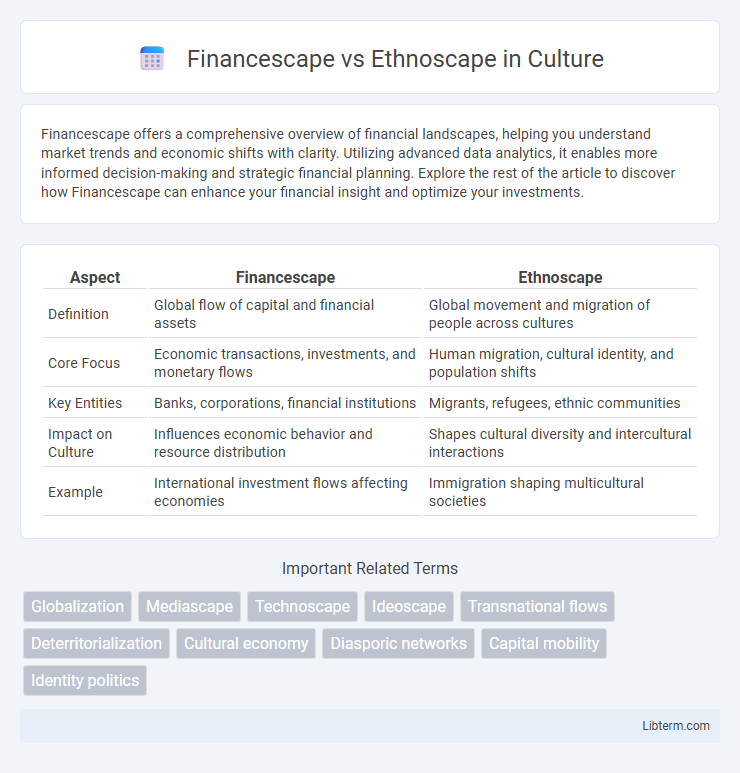Financescape offers a comprehensive overview of financial landscapes, helping you understand market trends and economic shifts with clarity. Utilizing advanced data analytics, it enables more informed decision-making and strategic financial planning. Explore the rest of the article to discover how Financescape can enhance your financial insight and optimize your investments.
Table of Comparison
| Aspect | Financescape | Ethnoscape |
|---|---|---|
| Definition | Global flow of capital and financial assets | Global movement and migration of people across cultures |
| Core Focus | Economic transactions, investments, and monetary flows | Human migration, cultural identity, and population shifts |
| Key Entities | Banks, corporations, financial institutions | Migrants, refugees, ethnic communities |
| Impact on Culture | Influences economic behavior and resource distribution | Shapes cultural diversity and intercultural interactions |
| Example | International investment flows affecting economies | Immigration shaping multicultural societies |
Introduction to Financescape and Ethnoscape
Financescape refers to the global financial environment shaped by capital flows, investment trends, and economic policies influencing international markets. Ethnoscape describes the landscape of migration and cultural exchanges, encompassing the movement and settlement of people across borders. Both concepts play crucial roles in understanding globalization's impact on economic structures and population dynamics.
Defining Financescape: Global Financial Flows
Financescape refers to the dynamic flows of global capital, encompassing investments, banking transactions, currency exchanges, and financial instruments that transcend national borders. It shapes economic landscapes by influencing markets, regulatory frameworks, and wealth distribution on an international scale. Unlike ethnoscape, which focuses on the movement of people and cultural groups, financescape captures the complex network of monetary resources driving globalization.
Understanding Ethnoscape: Migration and Mobility
Ethnoscape refers to the dynamic landscape of migration and mobility encompassing the movement of people, such as immigrants, refugees, tourists, and transnational communities, across global spaces. Understanding ethnoscape involves analyzing the cultural, social, and economic impacts of these human flows, highlighting how migration shapes identities, social networks, and urban environments. Unlike financescape, which maps the flow of capital and financial assets, ethnoscape centers on the physical and emotional experiences of human mobility and the resultant cultural transformations.
Key Differences Between Financescape and Ethnoscape
Financescape refers to the financial environment shaped by economic systems, market flows, and capital movements globally, emphasizing monetary transactions and resource allocation. Ethnoscape involves the dynamic landscapes of ethnic groups, migration patterns, and cultural identity formations influenced by social and political factors. Key differences lie in Financescape's focus on economic infrastructures and fiscal networks, whereas Ethnoscape centers on human migration, diaspora communities, and cultural interactions across borders.
Historical Context of Financescape and Ethnoscape
Financescape refers to the global financial systems and markets that have evolved significantly since the Bretton Woods Agreement of 1944, shaping international capital flows and economic policies. Ethnoscape involves the movement and migration of people, which intensified post-World War II due to decolonization, globalization, and transnational migration patterns. The historical context of Financescape emphasizes economic interdependence and capital mobility, while Ethnoscape centers on cultural exchange, identity formation, and diaspora dynamics shaped by geopolitical shifts.
Impact of Financescape on Global Economies
Financescape, encompassing global financial flows, investment patterns, and capital markets, significantly shapes global economies by influencing resource allocation, economic stability, and growth trajectories. The dynamic movement of capital within the Financescape affects currency exchange rates, cross-border investments, and financial market integration, driving economic interdependence and volatility among nations. In contrast to Ethnoscape, which relates to the movement of people and cultural exchange, Financescape's impact directly targets economic structures, financial policies, and international trade frameworks worldwide.
Ethnoscape’s Role in Shaping Cultural Landscapes
Ethnoscape plays a crucial role in shaping cultural landscapes by influencing the patterns of migration, settlement, and social interaction among diverse ethnic groups. It affects cultural identity and heritage through the movement and exchange of people, ideas, and practices across geographic boundaries. Ethnoscape contributes to the dynamic evolution of community structures and cultural expressions within both local and global contexts.
Intersections: How Financescape Influences Ethnoscape
Financescape shapes ethnoscape by determining migration patterns through economic opportunities and financial resources available to individuals and communities, influencing their decisions to relocate internationally. Capital flows, remittances, and global investment trends alter the demographics and cultural landscapes of host countries, thus reshaping ethnoscapes. Economic stability and financial access directly impact diaspora formation, transnational networks, and the mobility of ethnic groups across borders.
Challenges Presented by Financescape and Ethnoscape
Financescape challenges include financial volatility, unequal wealth distribution, and regulatory complexities that impact global economic stability and individual financial security. Ethnoscape challenges involve migration pressures, cultural integration difficulties, and identity conflicts that affect social cohesion and policy-making in multicultural societies. Both Financescape and Ethnoscape demand adaptive governance to balance economic dynamics with diverse human mobility and cultural interactions.
Future Trends: Financescape and Ethnoscape in a Globalized World
Financescape in a globalized world is rapidly evolving with advancements in digital currencies, cross-border financial technologies, and decentralized finance platforms driving unprecedented capital mobility and financial inclusion. Ethnoscape trends highlight increasing migration flows, diaspora networks, and transnational cultural exchanges reshaping social identities and labor markets amid geopolitical shifts and climate migration. Future interactions between financescape and ethnoscape will be crucial in shaping economic resilience, multicultural integration, and the global redistribution of wealth and skills.
Financescape Infographic

 libterm.com
libterm.com